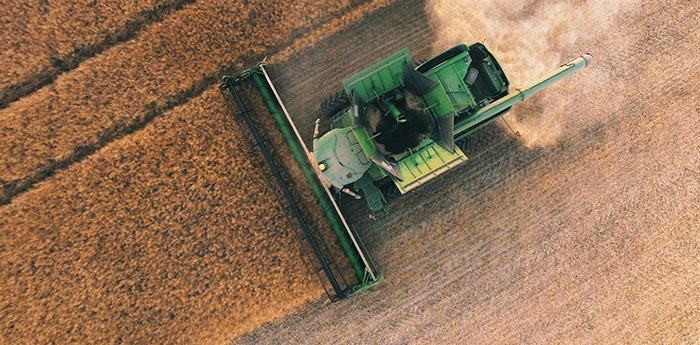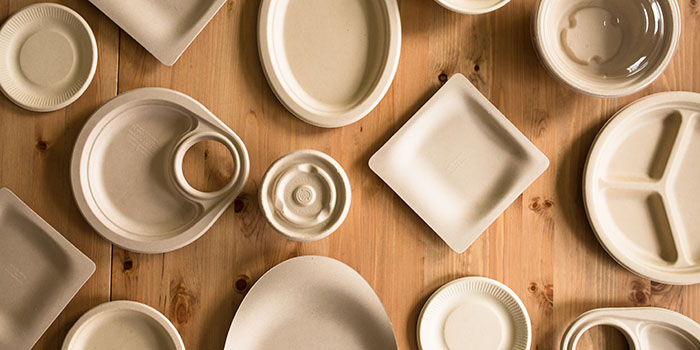In this guide, we will explore:
- What is fiber packaging and how is it made?
- What are the benefits of fiber packaging?
- Does fiber packaging have PFAS?
- Will takeout food leak through fiber packaging?
- What is the future of fiber packaging?
- Is the future right for my business?
What is fiber packaging and how is it made?
Fiber packaging is produced with reusable, renewable, or biodegradable materials. It’s primarily used in the construction, chemical, and food and beverage industries.
Fiber packaging can be made from different renewable agricultural feedstocks. These include recycled content (such as newspaper and cardboard) or natural fibers such as wood pulp, bamboo, bagasse, and wheat straw.
Fiber packaging also uses less energy to produce than petroleum-based products. It takes 2/3 less energy to make fiber containers, plates and bowls than it takes to make just one polystyrene foam plate.
In this post, we’re going to focus on bagasse and wheat straw fiber packaging. Each has a slightly different manufacturing process:
It takes 2/3 less energy to make fiber containers, plates and bowls than it takes to make just one polystyrene foam plate.
Molded fiber packaging made from bagasse
Bagasse comes from sugarcane production. Specifically, it is the fiber left on sugarcane stalks after the juice is extracted. The leftover fibers are blended with water until they create a pulp. That pulp is converted (via pressure and heat) to a variety of molded fiber products.

Molded fiber packaging made from wheat straw
The process for wheat straw fiber packaging is very similar to that of bagasse. Wheat straw, a byproduct of wheat, is the leftover stalk after the wheat has been harvested. The wheat straw is turned into pulp, and that pulp can be used to create molded fiber products.
Both wheat straw and bagasse are salvaged materials. They’re parts of wheat and sugarcane that are usually burned or destroyed. When converted into molded fiber and other paper products, these once wasted natural resources are finding new life.
Also, because these two resources are byproducts of the food supply chain, their use does not affect food security.
Fiber packaging boasts a lot of other benefits, too.
What are the benefits of fiber packaging?
Around 40% of all wood is harvested for commercial and industrial use. This leads to deforestation, social conflict, biodiversity losses, water pollution, and the emission of greenhouse gases. Nevertheless, paper products account for a large share of food service packaging materials.
Fiber product packaging provides an environmentally-friendly alternative to paper. It also provides a much-needed alternative to polystyrene (aka Styrofoam), which is detrimental to both the environment and human health.
Styrofoam takes 500 years or more to break down. It also uses 30% of the space in landfills and is made from non-renewable resources. An estimated 20% of Styrofoam never makes it to the landfill which means that it's in our oceans or cluttering up our parks and recreational space.
Styrofoam’s popularity persists because it is lightweight and cheap. Until fiber, there wasn’t an environmentally-friendly alternative.
Molded pulp packaging has other advantages for the environment and consumers too.

The environmental benefits of fiber packaging
- Completely biodegradable – Both materials naturally degrade over time. Wheat straw takes around 3–12 months to biodegrade naturally. Bagasse decomposition rate varies depending on moisture and heat levels.
- Compostable – Commercial composting facilities can compost wheat straw fiber in as little as 2–3 months and bagasse in 3 months.
- Made from renewable resources – All fiber protective packaging is made from renewable resources.
The food packaging benefits of fiber packaging
- Water and grease resistant
- Can withstand high temperatures (up to 200°F)
- Microwave and freezer safe
- Impressive durability
- Effective insulation
When you combine the functional and environmental benefits, fiber is an excellent alternative.
Does fiber packaging have PFAS?
Let’s address the topic of PFAS (or PER- and polyfluoroalkyl substances), the human-made chemicals found in some fiber packaging. PFAS has been used in the manufacturing process of thousands of products across the globe since the 1940s - everything from nonstick cookware to microwave popcorn bags.
But, recently PFAS has been linked to health and environmental issues. Naturally, the FDA, EPA, and manufacturers responded to these findings by removing many long-chain PFAS from the market.
Numerous states have banned PFAS in food packaging. Good Start Packaging has been a leader in urging food packaging manufacturers to offer environmentally-responsible containers and to be transparent about their supply chains. We only carry fiber containers with no added PFAS and are proud to have an expansive collection of PFAS-free food packaging products.
Will takeout food leak through fiber packaging?
We're also often asked about the performance of fiber packaging. For example, will foods leak through fiber containers? Can you store food in fiber containers in the fridge?
For most take-out, delivery, or leftover applications, our standard unlined fiber to-go boxes, clamshells, bowls, and trays are very effective.
For grab-and-go options and take-out items that have high liquid content or need to hold up for several days, we recommend premium PLA-lined fiber containers. The clear, bio-based, plastic-free lining of these containers provides an extra barrier for additional leak prevention.
What is the future of fiber packaging?
The fiber packaging industry looks bright.
Major food companies have committed to using fiber packaging including McDonald’s which aims to transition to 100% fiber packaging by 2025. Consumers have also become increasingly persistent, demanding sustainability with their buying power. Sustainable packaging provides a means to meet that growing demand.

Is fiber packaging right for my business??
If your food business currently uses any of the following items, then compostable fiber packaging is an ideal option:
Fiber is strong, durable and will function the same, if not better, than the containers you're using now, just without the detrimental environmental side effects. We even offer custom printed fiber clamshells to incorporate your branding for a memorable customer experience.
At Good Start Packaging, we’re committed to supplying high-quality wheat straw and bagasse fiber products at an affordable rate. Contact us to learn more about how our fiber packaging can help meet your sustainability goals.



